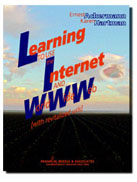| Summary Terms Exercises |
|
Chapter 5 |
|
|---|---|
Supplemental Material (avaialble on CD included with book)
- URLs from the chapter (HTML)
- Copies of the review questions in quiz format (PDF)
Communication is the most popular use of the Internet, with email topping
the list of all the technologies used. Some of the other types of communication
technologies used include email discussion groups, Usenet news, chat groups,
and IRC. These technologies are unique to networked computer environments
and have come into wide popularity because of the Internet. Most of the
communication technologies used on the Internet require communication
to be done using text-letters with some symbols and punctuation. Communicating
effectively involves taking the time-except in truly informal communications-to
use correct grammar, spelling, and punctuation as well as writing an appropriate
message. When replying to a message, include the pertinent parts of the
message and use an appropriate and interesting subject header.
When you're communicating on the Internet, take special care not to give out personal information to strangers and to treat others with respect. Be aware of the risks involved in communicating with people you cannot see and may never meet in person. Take time to consider what you write to others, and be careful to avoid humor and sarcasm except with the best of friends. You can't assume that your messages are private, so be careful about what you write.
Several ethical and legal considerations arise from using the Internet for communication. The manner in which communication is implemented on the Internet makes it susceptible to monitoring. You can't assume that communications are private. Some people believe that sending email is like sending a message on a postcard. Some laws have been enacted to help protect privacy during electronic communications. These, however, have been difficult to enforce and are rarely applied. One way to protect privacy is to encrypt or code a message. A common way of encrypting messages is through the use of public and private keys. Although software for encryption is readily available, current policies and laws prohibit its export.
Another area of concern is dealing with abusive or offensive communications.
Laws that apply to libel, harassment, and abuse have been applied to cases
where the offending behavior has occurred on the Internet. Unsolicited
email or other forms of communication is called spam. Spam definitely
is an annoyance, but it also can be quite costly to the people who receive
it. It's relatively inexpensive to produce spam because most of the cost
of transporting the email is shifted to the receiver and all the people
who use the networks supporting the Internet.
Terms
Exercises
Available on CD included with book.
This material has been prepared to accompany the book "Learning to Use the Internet and the World Wide Web" (ISBN 1-887902-78-3) by Ernest Ackermann and Karen Hartman, and published by Franklin, Beedle and Associates, Incorporated, Wilsonville, OR. © 2002. No part of this may be reproduced, stored in a retrieval system, or transcribed without permission of the publisher.
| You can help support this site by buying books, CDs, and other items after clicking on this link. |  |
Number of visits here since May 10, 2002.
